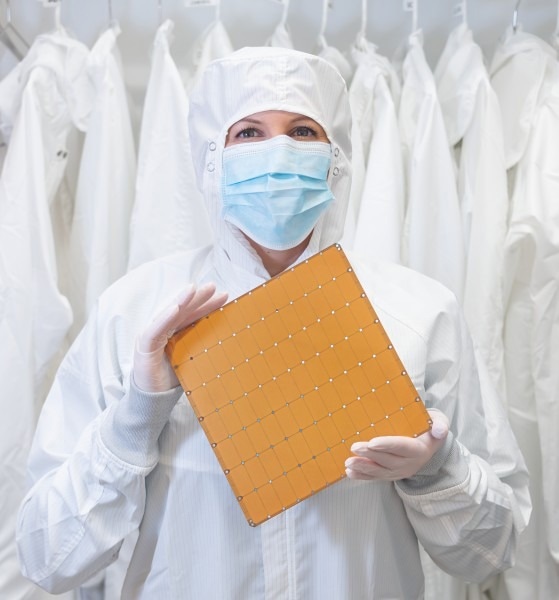Reviewed by Mila PereraOct 25 2022
The Wafer-Scale Engine technology from Cerebras Systems will be the subject of a project that Sandia National Laboratories is working on with collaborators from two other national labs.

A worker at Cerebras Systems holds the world’s largest computer wafer, to be used as part of the collaboration between Cerebras and Sandia, Los Alamos, and Lawrence Livermore national laboratories. The partnership will accelerate future advanced simulation and computing applications in support of the national nuclear stockpile. Image Credit: Cerebras Systems
The immediate goal is to expedite sophisticated simulation and computation applications that will help the nation’s stockpile stewardship mission.
The effort is sponsored by the National Nuclear Security Administration’s Advanced Simulation and Computing program, and Sandia, Lawrence Livermore, and Los Alamos national laboratories will partner with Cerebras Systems on the project.
The ultimate goal of NNSA’s Advanced Memory Technology research and development program is to develop technologies for use in future computing system procurements. We are funding research in technologies that have the potential to deliver 40 times the application performance of our forthcoming NNSA exascale systems.
Thuc Hoang, Director, Advanced Simulation and Computing Program, National Nuclear Security Administration
The Cerebras Wafer-Scale Engine, the world’s largest computer chip, was designed exclusively for artificial intelligence and machine learning work, according to Andrew Feldman, founder, and CEO of Cerebras Systems.
The engine contains 2.6 trillion transistors, 850,000 artificial intelligence cores and powers the Cerebras CS-2, the industry’s fastest artificial intelligence computer.
Andrew Feldman, Founder and CEO, Cerebras Systems
“This collaboration with Cerebras Systems has great potential to impact future mission applications by enabling artificial intelligence and machine learning techniques, which are an emerging component of our production simulation workloads,” adds Simon Hammond, Federal Program Manager for the ASC’s Computational Systems and Software Environments program.
The new agreement is part of NNSA’s post-Exascale-Computing-Initiative investment portfolio, which aims to maintain the initiative’s technology research and development pace, as well as its strong engagement with industry, which it began through its PathForward program.
It seeks to strengthen the domestic high-performance computing ecosystem by boosting industry competitiveness in next-generation high-performance computing technology.
Robert Hoekstra, senior manager of the extreme scale computing group at Sandia stated, “We anticipate technologies developed as part of the program will be tested on the Advanced Simulation and Computing program’s advanced architecture prototype systems and will eventually affect the production of advanced and commodity technology platforms used by the three labs.”
Feldman stated that his organization is honored to have been chosen for the work.
Cerebras is excited to collaborate with the pioneering researchers and scientists at Sandia, Lawrence Livermore and Los Alamos national laboratories. Cerebras exists to enable researchers and scientists to push the boundaries of current knowledge, helping them solve problems that are intractable on existing computer infrastructure, as well as vastly accelerate cutting-edge simulation workloads.
Andrew Feldman, Founder and CEO, Cerebras Systems
Feldman says, “Our multiyear partnership with the Advanced Simulation and Computing program will expand the boundaries of the application of artificial intelligence and high-performance computing to physics across a range of important applications.”
“The technology holds great potential for impacting how we accomplish our mission in the future,” notes James H. Laros III, Sandia Project Lead and Distinguished Member of Technical Staff, who is looking forward to the collaboration.